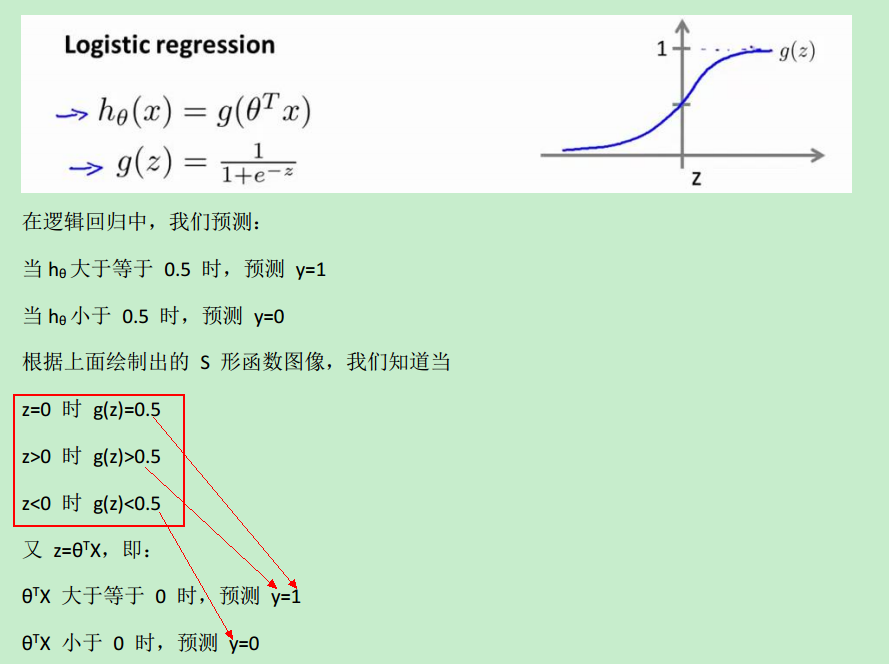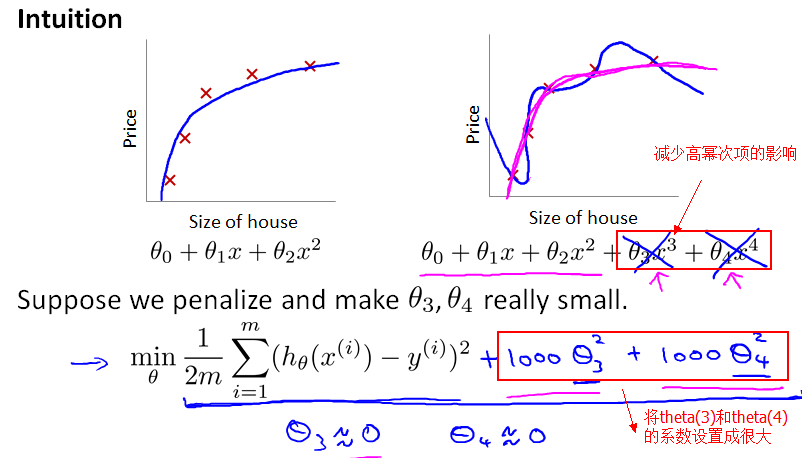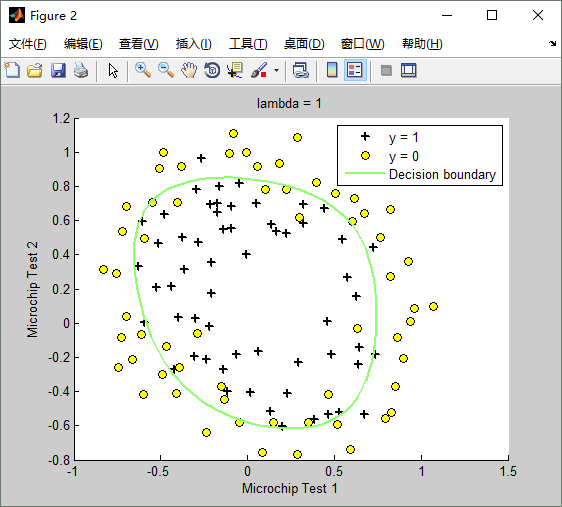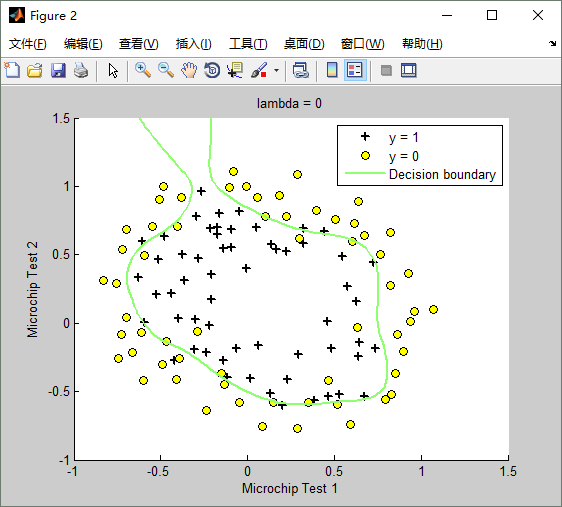Stanford coursera Andrew Ng 机器学习课程编程作业(Exercise 2)及总结
Exercise 1:Linear Regression---实现一个线性回归
关于如何实现一个线性回归,请参考:实现一个线性回归
Exercise 2:Logistic Regression---实现一个逻辑回归
问题描述:用逻辑回归根据学生的考试成绩来判断该学生是否可以入学。
这里的训练数据(training instance)是学生的两次考试成绩,以及TA是否能够入学的决定(y=0表示成绩不合格,不予录取;y=1表示录取)
因此,需要根据trainging set 训练出一个classification model。然后,拿着这个classification model 来评估新学生能否入学。
训练数据的成绩样例如下:第一列表示第一次考试成绩,第二列表示第二次考试成绩,第三列表示入学结果(0--不能入学,1--可以入学)
34.62365962451697, 78.0246928153624, 0
30.28671076822607, 43.89499752400101, 0
35.84740876993872, 72.90219802708364, 0
60.18259938620976, 86.30855209546826, 1
....
....
....
训练数据图形表示 如下:橫坐标是第一次考试的成绩,纵坐标是第二次考试的成绩,右上角的 + 表示允许入学,圆圈表示不允许入学。(分数决定命运,太悲惨了!)

该训练数据的图形 可以通过Matlab plotData函数画出来,它调用Matlab中的plot函数和find函数,Matlab代码实现如下:
function plotData(X, y)
%PLOTDATA Plots the data points X and y into a new figure
% PLOTDATA(x,y) plots the data points with + for the positive examples
% and o for the negative examples. X is assumed to be a Mx2 matrix.
% Create New Figure figure; hold on; % ====================== YOUR CODE HERE ======================
% Instructions: Plot the positive and negative examples on a
% 2D plot, using the option 'k+' for the positive
% examples and 'ko' for the negative examples.
% pos = find(y==);
neg = find(y==);
plot(X(pos, ), X(pos, ), 'k+', 'LineWidth', , 'MarkerSize', );
plot(X(neg, ), X(neg, ), 'ko', 'MarkerFaceColor', 'y', 'MarkerSize', );
% ========================================================================= hold off;
end
Matlab加载数据:
%% Load Data
% The first two columns contains the exam scores and the third column
% contains the label. data = load('ex2data1.txt');
X = data(:, [1, 2]); y = data(:, 3);% 矩阵 X 取数据的所有行的第一列和第二列,向量 y 取数据的第三列
由上面代码可知:Matlab将文本文件中的训练数据加载到 矩阵X 和 向量 y 中
加载完数据之后,执行以下代码(调用自定义的plotData函数),将图形画出来:
plotData(X, y); % Put some labels
hold on;
% Labels and Legend
xlabel('Exam 1 score') %标记图形的 X 轴
ylabel('Exam 2 score') %标记图形的 Y 轴 % Specified in plot order
legend('Admitted', 'Not admitted') %图形的右上角标签
hold off;
图形画出来之后,对训练数据就有了一个大体的可视化的认识了。接下来就要实现 模型了,这里需要训练一个逻辑回归模型。
①sigmoid function
对于 logistic regression而言,它针对的是 classification problem。这里只讨论二分类问题,比如上面的“根据成绩入学”,结果只有两种:y==0时,成绩未合格,不予入学;y==1时,可入学。即,y的输出要么是0,要么是1
如果采用 linear regression,它的假设函数是这样的:

假设函数的取值即可以远远大于1,也可以远远小于0,并且容易受到一些特殊样本的影响。比如在上图中,就只能约定:当假设函数大于等于0.5时;预测y==1,小于0.5时,预测y==0。
而如果引入了sigmoid function,就可以把假设函数的值域“约束”在[0, 1]之间。总之,引入sigmoid function,就能够更好的拟合分类问题中的数据,即从这个角度看:regression model 比 linear model 更合适 classification problem.
引入sigmoid后,假设函数如下:

sigmoid function 用Matlab 实现如下:
function g = sigmoid(z)
%SIGMOID Compute sigmoid functoon
% J = SIGMOID(z) computes the sigmoid of z. % You need to return the following variables correctly
g = zeros(size(z)); % ====================== YOUR CODE HERE ======================
% Instructions: Compute the sigmoid of each value of z (z can be a matrix,
% vector or scalar). g = 1./(ones(size(z)) + exp(-z)); % ‘点除’ 表示 1 除以矩阵(向量)中的每一个元素
% ============================================================= end
②模型的代价函数(cost function)
什么是代价函数呢?
把训练好的模型对新数据进行预测,那预测结果有好有坏。因此,就用cost function 来衡量预测的"准确性"。cost function越小,表示测的越准。这里的代价函数的本质是”最小二乘法“---ordinary least squares
代价函数的最原始的定义是下面的这个公式:可见,它是关于 theta 的函数。(X,y 是已知的,由training set 中的数据确定了)

那如何求解 cost function的参数 theta,从而确定J(theta)呢?有两种方法:一种是梯度下降算法(Gradient descent),另一种是正规方程(Normal Equation),本文只讨论Gradient descent。
而梯度下降算法,本质上是求导数(偏导数),或者说是:方向导数。方向导数所代表的方向--梯度方向,下降得最快。
而我们知道,对于某些图形所代表的函数,它可能有很多个导数为0的点,这类函数称为非凸函数(non-convex function);而某些函数,它只有一个全局唯一的导数为0的点,称为 convex function,比如下图:

convex function能够很好地让Gradient descent寻找全局最小值。而上图左边的non-convex就不太适用Gradient descent了。
就是因为上面这个原因,logistic regression 的 cost function被改写成了下面这个公式:

可以看出,引入log 函数(对数函数),让non-convex function 变成了 convex function
再精简一下cost function,其实它可以表示成:

J(theta)可用向量表示成:

其Matlab语言表示公式如下:
J = ( log( sigmoid(theta'*X') ) * y + log( 1-sigmoid(theta'*X') ) * (1 - y) )/(-m);
③梯度下降算法
上面已经讲到梯度下降算法本质上是求偏导数,目标就是寻找theta,使得 cost function J(theta)最小。公式如下:

上面对theta(j)求偏导数,得到的值就是梯度j,记为:grad(j)
通过线性代数中的矩阵乘法以及向量的乘法规则,可以将梯度grad表示成向量的形式:

至于如何证明的,可参考:Exercise 1:Linear Regression---实现一个线性回归
其Matlab语言表示公式如下:
grad = ( X' * ( sigmoid(X*theta)-y ) )/m; % X 为 training set 中的 feature variables, y 为training instance(训练样本的结果)结果
需要注意的是:对于logistic regression,假设函数h(x)=g(z),即它引入了sigmoid function.

最终,Matlab中costfunction.m如下:
function [J, grad] = costFunction(theta, X, y)
%COSTFUNCTION Compute cost and gradient for logistic regression
% J = COSTFUNCTION(theta, X, y) computes the cost of using theta as the
% parameter for logistic regression and the gradient of the cost
% w.r.t. to the parameters. % Initialize some useful values
m = length(y); % number of training examples % You need to return the following variables correctly
J = 0;
grad = zeros(size(theta)); % ====================== YOUR CODE HERE ======================
% Instructions: Compute the cost of a particular choice of theta.
% You should set J to the cost.
% Compute the partial derivatives and set grad to the partial
% derivatives of the cost w.r.t. each parameter in theta
%
% Note: grad should have the same dimensions as theta
% %J = (log(theta'*X')*y + (1-y)*log(1-theta'*X'))/(-m);
%attention matlab's usage
J = ( log( sigmoid(theta'*X') ) * y + log( 1-sigmoid(theta'*X') ) * (1 - y) )/(-m); % theta = theta - (alpha/m)*X'*(X*theta-y);
grad = ( X' * ( sigmoid(X*theta)-y ) )/m; % ============================================================= end
通过调用costfunction.m文件中定义的coustFunction函数,从而运行梯度下降算法找到使代价函数J(theta)最小化的 逻辑回归模型参数theta。调用costFunction函数的代码如下:
%% ============= Part 3: Optimizing using fminunc =============
% In this exercise, you will use a built-in function (fminunc) to find the
% optimal parameters theta. % Set options for fminunc
options = optimset('GradObj', 'on', 'MaxIter', 400); % Run fminunc to obtain the optimal theta
% This function will return theta and the cost
[theta, cost] = ...
fminunc(@(t)(costFunction(t, X, y)), initial_theta, options);
从上面代码的最后一行可以看出,我们是通过 fminunc 调用 costFunction函数,来求得 theta的,而不是自己使用 Gradient descent 在for 循环求导来计算 theta。for循环中求导计算theta,可参考:Exercise 1:Linear Regression---实现一个线性回归
既然已经通过Gradient descent算法求得了theta,将theta代入到假设函数中,就得到了 logistic regression model,用图形表示如下:

④模型的评估(Evaluating logistic regression)
那如何估计,求得的逻辑回归模型是好还是坏呢?预测效果怎么样?因此,就需要拿一组数据测试一下,测试代码如下:
%% ============== Part 4: Predict and Accuracies ==============
% After learning the parameters, you'll like to use it to predict the outcomes
% on unseen data. In this part, you will use the logistic regression model
% to predict the probability that a student with score 45 on exam 1 and
% score 85 on exam 2 will be admitted.
%
% Furthermore, you will compute the training and test set accuracies of
% our model.
%
% Your task is to complete the code in predict.m % Predict probability for a student with score 45 on exam 1
% and score 85 on exam 2 prob = sigmoid([1 45 85] * theta); %这是一组测试数据,第一次考试成绩为45,第二次成绩为85
fprintf(['For a student with scores 45 and 85, we predict an admission ' ...
'probability of %f\n\n'], prob); % Compute accuracy on our training set
p = predict(theta, X);% 调用predict函数测试模型 fprintf('Train Accuracy: %f\n', mean(double(p == y)) * 100); fprintf('\nProgram paused. Press enter to continue.\n');
pause;
模型的测试结果如下:
For a student with scores 45 and 85, we predict an admission probability of 0.774323 Train Accuracy: 89.000000
那predict函数是如何实现的呢?predict.m 如下:
function p = predict(theta, X)
%PREDICT Predict whether the label is 0 or 1 using learned logistic
%regression parameters theta
% p = PREDICT(theta, X) computes the predictions for X using a
% threshold at 0.5 (i.e., if sigmoid(theta'*x) >= 0.5, predict 1) m = size(X, 1); % Number of training examples % You need to return the following variables correctly
p = zeros(m, 1); % ====================== YOUR CODE HERE ======================
% Instructions: Complete the following code to make predictions using
% your learned logistic regression parameters.
% You should set p to a vector of 0's and 1's
%
p = X*theta >= 0; % ========================================================================= end
非常简单,只有一行代码:p = X * theta >= 0,原理如下:

当h(x)>=0.5时,预测y==1,而h(x)>=0.5 等价于 z>=0
⑤逻辑回归的正则化(Regularized logistic regression)
为什么需要正则化?正则化就是为了解决过拟合问题(overfitting problem)。那什么又是过拟合问题呢?
一般而言,当模型的特征(feature variables)非常多,而训练的样本数目(training set)又比较少的时候,训练得到的假设函数(hypothesis function)能够非常好地匹配training set中的数据,此时的代价函数几乎为0。下图中最右边的那个模型 就是一个过拟合的模型。

所谓过拟合,从图形上看就是:假设函数曲线完美地通过中样本中的每一个点。也许有人会说:这不正是最完美的模型吗?它完美地匹配了traing set中的每一个样本呀!
过拟合模型不好的原因是:尽管它能完美匹配traing set中的每一个样本,但它不能很好地对未知的 (新样本实例)input instance 进行预测呀!通俗地讲,就是过拟合模型的预测能力差。
因此,正则化(regularization)就出马了。
前面提到,正是因为 feature variable非常多,导致 hypothesis function 的幂次很高,hypothesis function变得很复杂(弯弯曲曲的),从而通过穿过每一个样本点(完美匹配每个样本)。如果添加一个"正则化项",减少 高幂次的特征变量的影响,那 hypothesis function不就变得平滑了吗?

正如前面提到,梯度下降算法的目标是最小化cost function,而现在把 theta(3) 和 theta(4)的系数设置为1000,设得很大,求偏导数时,相应地得到的theta(3) 和 theta(4) 就都约等于0了。
更一般地,我们对每一个theta(j),j>=1,进行正则化,就得到了一个如下的代价函数:其中的 lambda(λ)就称为正则化参数(regularization parameter)

从上面的J(theta)可以看出:如果lambda(λ)=0,则表示没有使用正则化;如果lambda(λ)过大,使得模型的各个参数都变得很小,导致h(x)=theta(0),从而造成欠拟合;如果lambda(λ)很小,则未充分起到正则化的效果。因此,lambda(λ)的值要合适。
最后,我们来看一个实际的过拟合的示例,原始的训练数据如下图:

lambda(λ)==1时,训练出来的模型(hypothesis function)如下:Train Accuracy: 83.050847

lambda(λ)==0时,不使用正则化,训练出来的模型(hypothesis function)如下:Train Accuracy: 87.288136

lambda(λ)==100时,训练出来的模型(hypothesis function)如下:Train Accuracy: 61.016949

Matlab正则化代价函数的实现文件costFunctionReg.m如下:
function [J, grad] = costFunctionReg(theta, X, y, lambda)
%COSTFUNCTIONREG Compute cost and gradient for logistic regression with regularization
% J = COSTFUNCTIONREG(theta, X, y, lambda) computes the cost of using
% theta as the parameter for regularized logistic regression and the
% gradient of the cost w.r.t. to the parameters. % Initialize some useful values
m = length(y); % number of training examples % You need to return the following variables correctly
J = 0;
grad = zeros(size(theta)); % ====================== YOUR CODE HERE ======================
% Instructions: Compute the cost of a particular choice of theta.
% You should set J to the cost.
% Compute the partial derivatives and set grad to the partial
% derivatives of the cost w.r.t. each parameter in theta
%J = ( log( sigmoid(theta'*X') ) * y + log( 1-sigmoid(theta'*X') ) * (1 - y) )/(-m);
%J = ( log( sigmoid(theta'*X') ) * y + log( 1-sigmoid(theta'*X') ) * (1 - y) )/(-m) + (lambda / (2*m)) * (theta'*theta);
J = ( log( sigmoid(theta'*X') ) * y + log( 1-sigmoid(theta'*X') ) * (1 - y) )/(-m) + (lambda / (2*m)) * ( ( theta( 2:length(theta) ) )' * theta(2:length(theta)) );
%grad = ( X' * ( sigmoid(X*theta)-y ) )/m;
grad = ( X' * ( sigmoid(X*theta)-y ) )/m + ( lambda / m ) * ( [0; ones( length(theta) - 1 , 1 )].*theta ); % ============================================================= end
调用costFunctionReg.m的代码如下:
%% ============= Part 2: Regularization and Accuracies =============
% Optional Exercise:
% In this part, you will get to try different values of lambda and
% see how regularization affects the decision coundart
%
% Try the following values of lambda (0, 1, 10, 100).
%
% How does the decision boundary change when you vary lambda? How does
% the training set accuracy vary?
% % Initialize fitting parameters
initial_theta = zeros(size(X, 2), 1); % Set regularization parameter lambda to 1 (you should vary this)
lambda = 1; % Set Options
options = optimset('GradObj', 'on', 'MaxIter', 400); % Optimize
[theta, J, exit_flag] = ...
fminunc(@(t)(costFunctionReg(t, X, y, lambda)), initial_theta, options); % Plot Boundary
plotDecisionBoundary(theta, X, y);
hold on;
title(sprintf('lambda = %g', lambda)) % Labels and Legend
xlabel('Microchip Test 1')
ylabel('Microchip Test 2') legend('y = 1', 'y = 0', 'Decision boundary')
hold off; % Compute accuracy on our training set
p = predict(theta, X); fprintf('Train Accuracy: %f\n', mean(double(p == y)) * 100);
⑥总结:
本文是对Stanford Machine Learning课程中的logistic regression的总结。结合课后编程习题,对logistic regression 各个知识点和编程作业中的代码、实现原理作了详细的解释。
有兴趣并且有时间学一名新技术是一件幸福的事情。
原文:http://www.cnblogs.com/hapjin/p/6078530.html
Stanford coursera Andrew Ng 机器学习课程编程作业(Exercise 2)及总结的更多相关文章
- Stanford coursera Andrew Ng 机器学习课程编程作业(Exercise 1)
Exercise 1:Linear Regression---实现一个线性回归 在本次练习中,需要实现一个单变量的线性回归.假设有一组历史数据<城市人口,开店利润>,现需要预测在哪个城市中 ...
- Stanford coursera Andrew Ng 机器学习课程第四周总结(附Exercise 3)
Introduction Neural NetWork的由来 时,我们可以对它进行处理,分类.但是当特征数增长为时,分类器的效率就会很低了. Neural NetWork模型 该图是最简单的神经网络, ...
- Stanford coursera Andrew Ng 机器学习课程第二周总结(附Exercise 1)
Exercise 1:Linear Regression---实现一个线性回归 重要公式 1.h(θ)函数 2.J(θ)函数 思考一下,在matlab里面怎么表达?如下: 原理如下:(如果你懂了这道作 ...
- 【原】Coursera—Andrew Ng机器学习—课程笔记 Lecture 1_Introduction and Basic Concepts 介绍和基本概念
目录 1.1 欢迎1.2 机器学习是什么 1.2.1 机器学习定义 1.2.2 机器学习算法 - Supervised learning 监督学习 - Unsupervised learning 无 ...
- 【原】Coursera—Andrew Ng机器学习—课程笔记 Lecture 15—Anomaly Detection异常检测
Lecture 15 Anomaly Detection 异常检测 15.1 异常检测问题的动机 Problem Motivation 异常检测(Anomaly detection)问题是机器学习算法 ...
- 【原】Coursera—Andrew Ng机器学习—课程笔记 Lecture 17—Large Scale Machine Learning 大规模机器学习
Lecture17 Large Scale Machine Learning大规模机器学习 17.1 大型数据集的学习 Learning With Large Datasets 如果有一个低方差的模型 ...
- 【原】Coursera—Andrew Ng机器学习—课程笔记 Lecture 16—Recommender Systems 推荐系统
Lecture 16 Recommender Systems 推荐系统 16.1 问题形式化 Problem Formulation 在机器学习领域,对于一些问题存在一些算法, 能试图自动地替你学习到 ...
- 【原】Coursera—Andrew Ng机器学习—课程笔记 Lecture 14—Dimensionality Reduction 降维
Lecture 14 Dimensionality Reduction 降维 14.1 降维的动机一:数据压缩 Data Compression 现在讨论第二种无监督学习问题:降维. 降维的一个作用是 ...
- 【原】Coursera—Andrew Ng机器学习—课程笔记 Lecture 12—Support Vector Machines 支持向量机
Lecture 12 支持向量机 Support Vector Machines 12.1 优化目标 Optimization Objective 支持向量机(Support Vector Machi ...
随机推荐
- MySQL建表规范与常见问题
一. 表设计 库名.表名.字段名必须使用小写字母,“_”分割. 库名.表名.字段名必须不超过12个字符. 库名.表名.字段名见名知意,建议使用名词而不是动词. 建议使用InnoDB存储引擎. 存储精确 ...
- luogg_java学习_03_流程控制及循环结构
本文为博主辛苦总结,希望自己以后返回来看的时候理解更深刻,也希望可以起到帮助初学者的作用. 转载请注明 出自 : luogg的博客园 谢谢配合! 程序流程控制 顺序结构 分支结构:if-else,sw ...
- MongoDB学习-在.NET中的简单操作
1.新建MVC项目, 管理NuGet包,进入下载MongDB.net库文件 2.新增项目DAL数据访问层,引用以下库文件: 3.C# 访问MongoDB通用方法类: using MongoDB.Dri ...
- Sharepoint2013:日期控件报错
1 问题 1> 在sharepoint中的,日期控件(DateTimeControl),日期过滤控件(Date Filter)和SPListViewFilter等包含日期组件的控件,在特定情况下 ...
- Centos安装Memcached和(Nginx)Memcache扩展详细教程
下载memadmin,下载地址:http://www.junopen.com/memadmin/ 并在IIS新建站点. 测试地址:http://wap.yousawang.com/mem , 1.重启 ...
- 唯美!分享8款响应式的 WordPress 餐厅主题
您是否拥有一个餐厅,酒吧,咖啡馆,小酒馆,比萨饼店?如果答案是肯定的,请确保您在网上也提供服务.为了使您的工作更轻松,我们选择了一些新的和独特的餐厅主题,覆盖了范围很广的食品企业.这些主题提供了很多很 ...
- Apache 配置屏蔽某些请求头
Apache配置文件代码.xwamp:Windows下搭建Apache + PHP + MySQL环境 <Location /> SetEnvIfNoCase User-Agent &qu ...
- datagridview的数据存取
这里主要是复习DataSet等数据或ADO.NET方面的知识.下面是一个简单的数据存储(在DataGridView上增加一行然后并存储到数据库的过程): private void button1_Cl ...
- 规划SharePoint2010的管理员密码更改
规划自动密码更改 (SharePoint Server 2010) 为了简化密码管理,自动密码更改功能允许您更新和部署密码,而不必在多个帐户.服务和 Web 应用程序之间执行手动密码更新任务.您可以配 ...
- javascript的浅拷贝和深拷贝
1.浅拷贝:复制一份引用,所有引用对象都指向一份数据,并且都可以修改这份数据. 2.深拷贝(复杂):复制变量值,对于非基本类型的变量,则递归至基本类型变量后,再复制. 这里画一个简单的图来加深理解: ...
